 Every few months a scientist claims that human evolution occurred because of some new factor: language, fire, meat eating, walking, etc. It is always related to hunter-gatherer’s in the African grassland (a savanna is a dry grassland that has some trees). Many have created theories of the current human mind based on the false assumption that human evolution occurred in one environment over a relatively short period of time. These theories falsely conflate modern human genetics and complex behavior with that one simple environment. Unfortunately, these stories are pure speculation based on little science. A previous post, How Long have People Been Smart, outlines the timeline of human ancestor achievements based on actual scientific fossil findings in the past eight million years. It shows that human ancestors have been smart for millions of years. For detailed information from 8 million years ago to three thousand years ago please see that post.
Every few months a scientist claims that human evolution occurred because of some new factor: language, fire, meat eating, walking, etc. It is always related to hunter-gatherer’s in the African grassland (a savanna is a dry grassland that has some trees). Many have created theories of the current human mind based on the false assumption that human evolution occurred in one environment over a relatively short period of time. These theories falsely conflate modern human genetics and complex behavior with that one simple environment. Unfortunately, these stories are pure speculation based on little science. A previous post, How Long have People Been Smart, outlines the timeline of human ancestor achievements based on actual scientific fossil findings in the past eight million years. It shows that human ancestors have been smart for millions of years. For detailed information from 8 million years ago to three thousand years ago please see that post.
Fossil remains are excavated by archaeologists – using material remains to study ancient or recent human history that is analyzed to ascertain questions we have about thousands or millions of years ago. As more and more remains are excavated from the ground, our picture of how humans have evolved have continuously been amended. Students can study archaeology and pursue different career options such as lab research or site excavation.
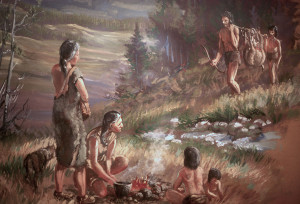 This post summarizes current scientific data that might explain human evolution. The picture that emerges from a large amount of different data sources (described later in this post) is that human ancestors lived in many varied environments and climates (wetness and dryness – stability and rapid change). It, also, shows that many different groups evolved and mingled over a period of millions of years. Possibly, the major characteristics that enabled human evolution are awareness, cleverness and adaptability to new and changing environments during the past three million years.
This post summarizes current scientific data that might explain human evolution. The picture that emerges from a large amount of different data sources (described later in this post) is that human ancestors lived in many varied environments and climates (wetness and dryness – stability and rapid change). It, also, shows that many different groups evolved and mingled over a period of millions of years. Possibly, the major characteristics that enabled human evolution are awareness, cleverness and adaptability to new and changing environments during the past three million years.
The firm conclusion of current research is that modern characteristics that are considered essential to human evolution did not develop in one simple environment and time, but rather over a very long period in different ways with many diverse interacting groups in many climates and environments. The real data shows new complexity in human evolution story.
Human Evolution Timeline
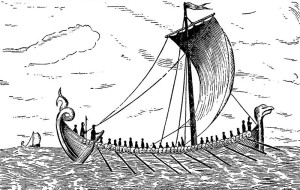 Previous posts described the increasing knowledge of early human ancestors, living many years earlier than previously thought. This includes use of tools at 2.7 million years ago, fire at one million years ago, significant sea travel to Island in Indonesia at least 1.7 million years ago. The question was asked in the previous post, how long have human ancestors been smart? And the answer is a lot longer than previously thought. It is certainly not easy to travel in the ocean and build a new civilization. I wonder how many people today could do that? Important milestones from fossils include the following: (see previous post for much more detailed timeline)
Previous posts described the increasing knowledge of early human ancestors, living many years earlier than previously thought. This includes use of tools at 2.7 million years ago, fire at one million years ago, significant sea travel to Island in Indonesia at least 1.7 million years ago. The question was asked in the previous post, how long have human ancestors been smart? And the answer is a lot longer than previously thought. It is certainly not easy to travel in the ocean and build a new civilization. I wonder how many people today could do that? Important milestones from fossils include the following: (see previous post for much more detailed timeline)
Mya = million years ago
- 7 mya – A skull from Chad with a human style brain
- 6 mya – In Kenya a human ancestor walked upright at 6 million years ago.
- 3.4 mya – Fossils of second hominid line living alongside Lucy
- 3 mya – Modern middle ear bones implies communication
 3 mya – First stone tools
3 mya – First stone tools- 2.6 mya – More advanced flake tools for stripping meat
- 2.3 mya – Homo habilis – head 1.5 x larger
- 2 mya – Modern shoulders for accurate throwing
- 2 mya– Great variation in skullx in one site
- 2 mya – Sediba shows modern jaws and teeth and unusual upright walking
- 1.9 mya to 200 kya – Homo erectus – head 2 x larger
- 1.95 mya – multiple homo lineages in Kenya
- 1.8 mya – Dmanisi, Georgia – ancestors could have evolved in Eurasia then back to Africa
- 1.76 mya – Bifacial stone tools in Kenya
- 1.7 mya – Modern dexterous hand for advanced tool making
- 1.7 mya – Travel by sea to Flores Island, Indonesia
- 1 mya – nearly modern foot.
- 1 mya– Homo heidelbergensis – head 3x larger
- 1 mya – Burned bone and plants showing controlled use of fire
Knowledge of Human Evolution is Based on Fossils
 Human evolution can only be surmised from the fossils that have been found of human ancestors. As more fossils are found and the scientific analysis becomes more accurate, the exact story of human evolution has become more complex, not simpler and clearer. Up until recently, many thought that human evolution could be understood as related to particular African grassland hunter gatherers as the climate became drier at one particular time in history.
Human evolution can only be surmised from the fossils that have been found of human ancestors. As more fossils are found and the scientific analysis becomes more accurate, the exact story of human evolution has become more complex, not simpler and clearer. Up until recently, many thought that human evolution could be understood as related to particular African grassland hunter gatherers as the climate became drier at one particular time in history.
But, the wide range of different human ancestors that are now known to lived over the past three million years, makes this much too simplistic.
Homo erectus was considered a strong candidate as a direct ancestor of modern humans. Erectus was on the African savannah open country and had developed several characteristics that made it seem that they were the direct descendants of modern humans. These characteristics included large bodies that are linear with long legs and large brains that used a lot of energy. They increasingly ate meat, had long lives, made tools and exhibited cooperation. It was thought that they suddenly developed enlargement of the brain related to living in this environment, as well as a new ability to move long distances and stay alive much longer. Some have even attempted to explain modern behavior based on genetic theories from this moment in time.
New discoveries have completely altered this picture, but the theories of human evolution that we hear from psychologists and biologists have not changed with the new information. In fact, human ancestors did not evolve in one type of climate and savanna, but rather over a long period of time, with many very different climates and changes of anatomy and behavior. The fossil record is not consistent with the narrow savannah theories.
These previous theories were related to Homo habilis and rudolfensis, but in fact, the relationship of these two species is not really clear because of the lack of fossil information. Information was not known but inferred.
 New fossil discoveries show many different groups that have different sizes of body and brain, as well as different sized teeth. The recent discoveries show that some of these developed up to 2 and a half million years earlier and some much later than the African grassland. Possibly, it has been the ability of various human ancestors to constantly adapt to different types of environments, including being flexible in how they ate, that allowed them to survive.
New fossil discoveries show many different groups that have different sizes of body and brain, as well as different sized teeth. The recent discoveries show that some of these developed up to 2 and a half million years earlier and some much later than the African grassland. Possibly, it has been the ability of various human ancestors to constantly adapt to different types of environments, including being flexible in how they ate, that allowed them to survive.
There are many other inconsistencies. Evidence shows much earlier high-level tool use that allowed flexible responses to situations. An earlier ancestor called Australopithecus, also, had long legs. Other characteristics of narrow pelvis and long life do not occur until much later.
Many Different Interacting Groups with Unclear Relationships

Current research is much more consistent with human ancestors that were very flexible in their behavior based on the many different environments they found themselves in. Their diets were flexible and variable. They were able to use knowledge of these different environments to expand their reach and live longer.
East Africa has unique geological features that allow preservation of precise fossil remains, and because of this, a more accurate timescale of behaviors and physical development has emerged. In addition, there are many recent fossil finds in Georgia, Dmanisi; Malapa; and South Africa that enlarge the timescale of human development.
The names that have been given to the Homo species have been altered as new fossils are found. The name for the most recent humans is Homo sapiens. Several different findings were combined into the erectus group 70 years ago, then a new category rudolfensis was established in 1986. More recently, there has been a need to alter several categories making habilis and rudolfensis the same group as “Lucy”, or Australopithecus.
The fossils found in Dmanisi, Georgia in Europe can be compared to various Homo fossils, including those found in Africa, dating back to about 2.4 million years ago, as well as others unearthed in Asia and Europe, which are dated between 1.8 and 1.2 million years ago.
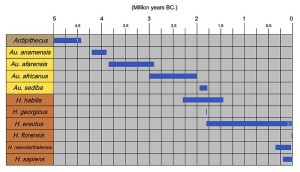 The recent work shows that all human ancestors since 3.5 million years ago had a very varied diet using many different plants (using two different photosynthesis types – C3 and C4) as well as meat. Both the large and small-bodied people found have the same types of efficient legs. Efficiency in walking and running is now known to be related to the size of the legs in relation to the size of the body. Also, some of the earliest (afarensis) show arches that help movement. These very early ancestors all had good walking ability long before any of the Homo species. In addition, all of the Homo groups, including very early types, have larger body and brain than Australopithicus.
The recent work shows that all human ancestors since 3.5 million years ago had a very varied diet using many different plants (using two different photosynthesis types – C3 and C4) as well as meat. Both the large and small-bodied people found have the same types of efficient legs. Efficiency in walking and running is now known to be related to the size of the legs in relation to the size of the body. Also, some of the earliest (afarensis) show arches that help movement. These very early ancestors all had good walking ability long before any of the Homo species. In addition, all of the Homo groups, including very early types, have larger body and brain than Australopithicus.
In fact, it is very hard to define an early Homo species from the evidence. They had smaller teeth and jaws and different facial shapes. The earliest are from Ethiopia from 2.33 million years ago and Malawi around 2 million years ago. There is no clear evidence for brain size in these.
There are many other findings in the period from 1.5 million to 2.1 million years ago. Sediba at 1.98 mya has unique features including modern teeth, pelvis and chest, but the face, walking and brain size are not modern.
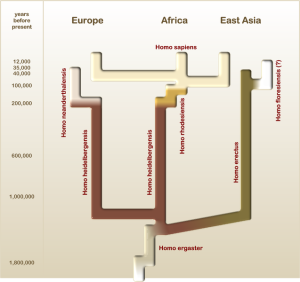 East African fossils include many different types after 2 mya including those with small and large brains and large bodies. There are three groups that all appear to be Homo from 2 mya to 1.5 mya with brains and bodies larger than Australopithecus. One has a 30% bigger brain and 10% bigger body. African and Georgian groups have 40% bigger brain and 25% bigger body. Early erectus has 20% bigger brain and 15% bigger body. But, in all of these there is great variation in size, as there is now.
East African fossils include many different types after 2 mya including those with small and large brains and large bodies. There are three groups that all appear to be Homo from 2 mya to 1.5 mya with brains and bodies larger than Australopithecus. One has a 30% bigger brain and 10% bigger body. African and Georgian groups have 40% bigger brain and 25% bigger body. Early erectus has 20% bigger brain and 15% bigger body. But, in all of these there is great variation in size, as there is now.
Another group in Kenya has different teeth. Many others have great variations in teeth, facial size but not shape, and body size. It might be added that modern people also show this type of variation. There were small people found in Gona, Ethiopia.
From 2 mya to 1 mya early erectus is prominent in East Africa but also South Africa; Dmanisi, Georgia; Java, Indonesia; and China. These all have different sizes but appear to be part of the same species.
Body Variations in Georgia – Europe
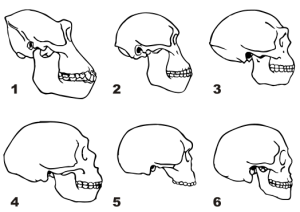 In Dmanisi, Georgia from 1.8 mya, five excellent skulls are preserved and show a range of sizes of bodies. They, also, have primitive smaller brains, which means that they could have dispersed from Africa much earlier than the later ancestors with large brains. This research implies that all of these variations are part of the same group, much as modern humans have wide variation.
In Dmanisi, Georgia from 1.8 mya, five excellent skulls are preserved and show a range of sizes of bodies. They, also, have primitive smaller brains, which means that they could have dispersed from Africa much earlier than the later ancestors with large brains. This research implies that all of these variations are part of the same group, much as modern humans have wide variation.
Most research, now, is consistent with three distinct groups of early Homo existing in Africa. Both the Dmanisi (1.8 mya) fossils and sediba (1.98 mya) fossils demonstrate that there is much more size variation than previously thought in different groups.
Very Different Environments and Climates
 In the past three million years, it appears that extremely variable conditions is the rule, rather than the narrow focus on grasslands with some trees (the famous savannah). The savannah view has been that human evolution was connected to cooling and drying with the development of very dry African open vegetation. The theory was that the development of savanna grasslands lead to making stone tools and eating more meat.
In the past three million years, it appears that extremely variable conditions is the rule, rather than the narrow focus on grasslands with some trees (the famous savannah). The savannah view has been that human evolution was connected to cooling and drying with the development of very dry African open vegetation. The theory was that the development of savanna grasslands lead to making stone tools and eating more meat.
The recent data includes much more detailed analyses of dust, lakes, volcanoes, tectonic plates and types of animals. This data demonstrates a wide variation and changeability of climate including alternating dominant dryness and wetness and changing resources. These changing climates make adaptability to many different situations the dominant characteristic of early humans and animals at that time.
Previous data from Kenya emphasized the dryness from 3 mya to 1.5 mya. But more accurate recent data show great diversity in the vegetation and wetness. During this long period, the savannas ranged from having 5% trees to 80% tree cover. Studies have shown very big differences in the size of lakes and the amount of monsoons. These along with volcanic effects and tectonic effects created instability in East Africa.
Recent astronomy finds that Earth’s orbit has many eccentricities that are based on complex orbit characteristics. Measurements of these cycles appear in studies of the Arabian Sea and Mediterranean. Carbon isotope studies of soil show these cycles imprinted in the rocks of East Africa near Olduvai and Turkana.
 These unusual factors have created cycles of wetness and dryness every 20,000 years; other astronomical cycles altered the pattern of seasonal rainfall every 100,000 years and 413,000 years. These patterns created the climates that human ancestors had to deal with during the long evolution. They included dramatic increases in monsoons at some times, dryness at others, as well as periods of great change and periods of stability during these millions of years.
These unusual factors have created cycles of wetness and dryness every 20,000 years; other astronomical cycles altered the pattern of seasonal rainfall every 100,000 years and 413,000 years. These patterns created the climates that human ancestors had to deal with during the long evolution. They included dramatic increases in monsoons at some times, dryness at others, as well as periods of great change and periods of stability during these millions of years.
Significantly, there are lengthy periods where the climate was very unpredictable and human ancestors had to survive through it. This unpredictability was prominent in seasonal rainfall in Africa. Dietary patterns were extremely influenced by these dramatic alterations of rain and dryness.
Changeability, Adaptability and Cognitive Evolution
The great changeability and need for adaptations to unpredictable situations affects tool making, transport of stones, body and brain size, teeth size, and expansion of the types of foods. But, the dramatic changes would put pressure on plasticity of the nervous system — the need to learn new techniques, and the need to somehow preserve social connections in this flux. All of these could be pressure to increase brain size.
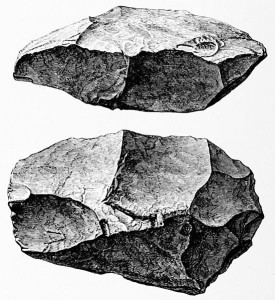 Food and Tools: Chemical isotope studies shows that during this long period there is a great diversity in use of carbon based foods. One group shows that changes in teeth allowed eating of tougher plant products and animal meat.
Food and Tools: Chemical isotope studies shows that during this long period there is a great diversity in use of carbon based foods. One group shows that changes in teeth allowed eating of tougher plant products and animal meat.
Other groups had teeth that could eat a much broader range of material. These could eat more meat and developed more tools to prepare the diverse meals. Tools were used to cut meat from at least 2.6 mya. Other tools show animal butchery and use for fish, as well as plants that have roots and tubers. Stone tools were carried for many miles, which shows their great value.
These tools show expansion throughout Africa and western Asia by 1.85 mya. Very advanced tools called Acheulean are found in France showing that this technology existed in Africa and India about 1.6 mya, and in Europe 0.8 mya
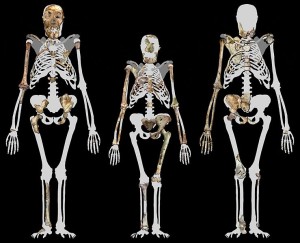 Body Size: Even with variation in body size, there is a trend of gradually larger sized bodies. The erectus group has variation in size similar to modern humans. The types of food and length of life influence body size. Larger size occurs when there is stability in food sources and less risk of death from predators or microbes. Increased social activity also influences mortality. In places with great variability, there is smaller size, like other primates. Larger size is influenced by the energy needs of travel to supply food, and if meat is prominent food.
Body Size: Even with variation in body size, there is a trend of gradually larger sized bodies. The erectus group has variation in size similar to modern humans. The types of food and length of life influence body size. Larger size occurs when there is stability in food sources and less risk of death from predators or microbes. Increased social activity also influences mortality. In places with great variability, there is smaller size, like other primates. Larger size is influenced by the energy needs of travel to supply food, and if meat is prominent food.
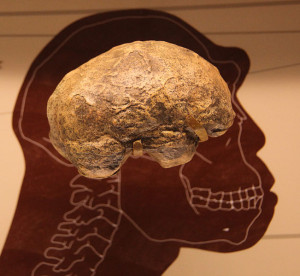
Brain Size : Large brains use more energy and require increased amounts of high quality food. Brain size gradually increased from Australopithecus to the first Homo and then to the later erectus before sapiens. This use of more energy for the brain means that the gut and the legs have to be more efficient to use less energy.
Also, with large brains, the growth of the fetus has to be slower. It appears that these alterations gradually occured over the longer time period. A way to be more efficient is to have increased social cooperation, rather than doing all the work alone. Another factor is that reproduction has to be fast enough to maintain the society. When there is great cooperation it tends to increase earlier weaning, and more children.
First Plasticity and then Genetics?
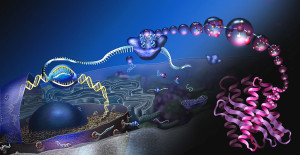 Changes needed to adapt to dramatically changing environments, as well as maintaining social structures and high quality food, might be quite rapid. Neuroplasticity and epigenetics might be the first lines of change with genetic alterations occurring much later.
Changes needed to adapt to dramatically changing environments, as well as maintaining social structures and high quality food, might be quite rapid. Neuroplasticity and epigenetics might be the first lines of change with genetic alterations occurring much later.
Many different groups used different approaches to the tasks at hand, and with the dietary flexibility and increased cooperation, brain size and body size grew bigger. In order to leave Africa and travel to completely different regions like Asia and Europe even greater flexibility is necessary. Traveling in the ocean is an extraordinary adaptation. In Asia, there were many different sites and groups. It is not known whether erectus was the first to travel to Asia, or floresiensis, which demonstrated the advanced ability of traveling at sea.
 Specific details of importance in human evolution did not evolve in one place and period. They evolved over long periods of time in many different groups in dramatically variable climates and habitats. These characteristics of modern humans that evolved from these interactions include:
Specific details of importance in human evolution did not evolve in one place and period. They evolved over long periods of time in many different groups in dramatically variable climates and habitats. These characteristics of modern humans that evolved from these interactions include:
- Large brains
- Reduced face and teeth size
- Long legs and shorter arms
- Narrow hips
- Modern hands
- Tool making and culture with language
- Variable expanded food including vegetables and meat
- Hunting
- Longer life
- Slower production of children
- Social integration and cooperation
In the current understanding the first long legs appeared at from 3.9 mya to 1.9 mya; stone technology first appeared at 2.6 mya; modern facial charateristics developed by 2.4 mya; larger brains and bodies by 1.9 to 1.5 mya.
New Complexity in Human Evolution Story
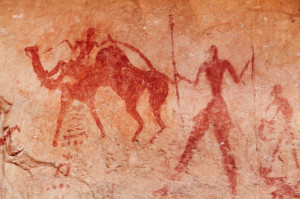 Great advances in many fields, including geology, astronomy, biology, physics and chemistry, as well as increasingly complex fossil findings demonstrate that it is not possible to consider human evolution occurring in one climate and environment over a relatively brief period. The scientific data show that multiple weather cycles occurred including very rainy, very dry, very unstable and periods of stability.
Great advances in many fields, including geology, astronomy, biology, physics and chemistry, as well as increasingly complex fossil findings demonstrate that it is not possible to consider human evolution occurring in one climate and environment over a relatively brief period. The scientific data show that multiple weather cycles occurred including very rainy, very dry, very unstable and periods of stability.
Also, over at least three million years, a wide variety of groups in very diverse environments and climates developed modern human characteristics at different rates. The current information does not clearly explain a lineage. The data raises the possibly that important characteristics of the developing human ancestors could have been awareness, adaptability and flexibility in types of food and behavior in all of these climates, environments and interacting groups. Gradually, the important characteristics appear to have evolved from many different interacting groups in different time schedules.
Awareness, flexibility and adaptability are the hallmark of intelligent creatures throughout evolution and certainly could be a very important impetus of human evolution, as well.
